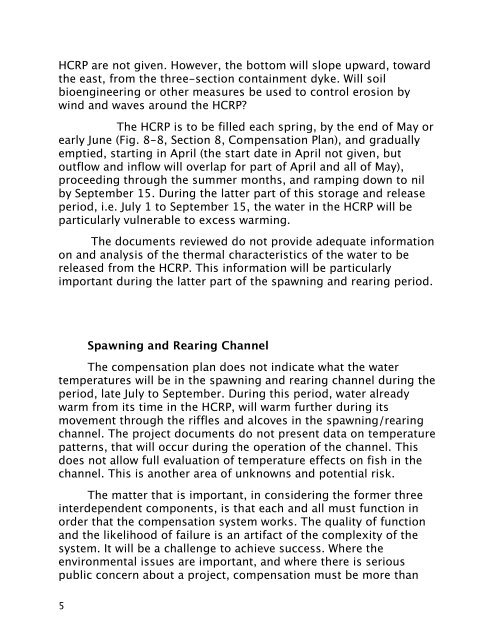From: on behalf of Panel Registry Subject: FW: TNG registration of ...
From: on behalf of Panel Registry Subject: FW: TNG registration of ...
From: on behalf of Panel Registry Subject: FW: TNG registration of ...
Create successful ePaper yourself
Turn your PDF publications into a flip-book with our unique Google optimized e-Paper software.
HCRP are not given. However, the bottom will slope upward, toward<br />
the east, from the three-secti<strong>on</strong> c<strong>on</strong>tainment dyke. Will soil<br />
bioengineering or other measures be used to c<strong>on</strong>trol erosi<strong>on</strong> by<br />
wind and waves around the HCRP?<br />
The HCRP is to be filled each spring, by the end <strong>of</strong> May or<br />
early June (Fig. 8-8, Secti<strong>on</strong> 8, Compensati<strong>on</strong> Plan), and gradually<br />
emptied, starting in April (the start date in April not given, but<br />
outflow and inflow will overlap for part <strong>of</strong> April and all <strong>of</strong> May),<br />
proceeding through the summer m<strong>on</strong>ths, and ramping down to nil<br />
by September 15. During the latter part <strong>of</strong> this storage and release<br />
period, i.e. July 1 to September 15, the water in the HCRP will be<br />
particularly vulnerable to excess warming.<br />
The documents reviewed do not provide adequate informati<strong>on</strong><br />
<strong>on</strong> and analysis <strong>of</strong> the thermal characteristics <strong>of</strong> the water to be<br />
released from the HCRP. This informati<strong>on</strong> will be particularly<br />
important during the latter part <strong>of</strong> the spawning and rearing period.<br />
5<br />
Spawning and Rearing Channel<br />
The compensati<strong>on</strong> plan does not indicate what the water<br />
temperatures will be in the spawning and rearing channel during the<br />
period, late July to September. During this period, water already<br />
warm from its time in the HCRP, will warm further during its<br />
movement through the riffles and alcoves in the spawning/rearing<br />
channel. The project documents do not present data <strong>on</strong> temperature<br />
patterns, that will occur during the operati<strong>on</strong> <strong>of</strong> the channel. This<br />
does not allow full evaluati<strong>on</strong> <strong>of</strong> temperature effects <strong>on</strong> fish in the<br />
channel. This is another area <strong>of</strong> unknowns and potential risk.<br />
The matter that is important, in c<strong>on</strong>sidering the former three<br />
interdependent comp<strong>on</strong>ents, is that each and all must functi<strong>on</strong> in<br />
order that the compensati<strong>on</strong> system works. The quality <strong>of</strong> functi<strong>on</strong><br />
and the likelihood <strong>of</strong> failure is an artifact <strong>of</strong> the complexity <strong>of</strong> the<br />
system. It will be a challenge to achieve success. Where the<br />
envir<strong>on</strong>mental issues are important, and where there is serious<br />
public c<strong>on</strong>cern about a project, compensati<strong>on</strong> must be more than
















